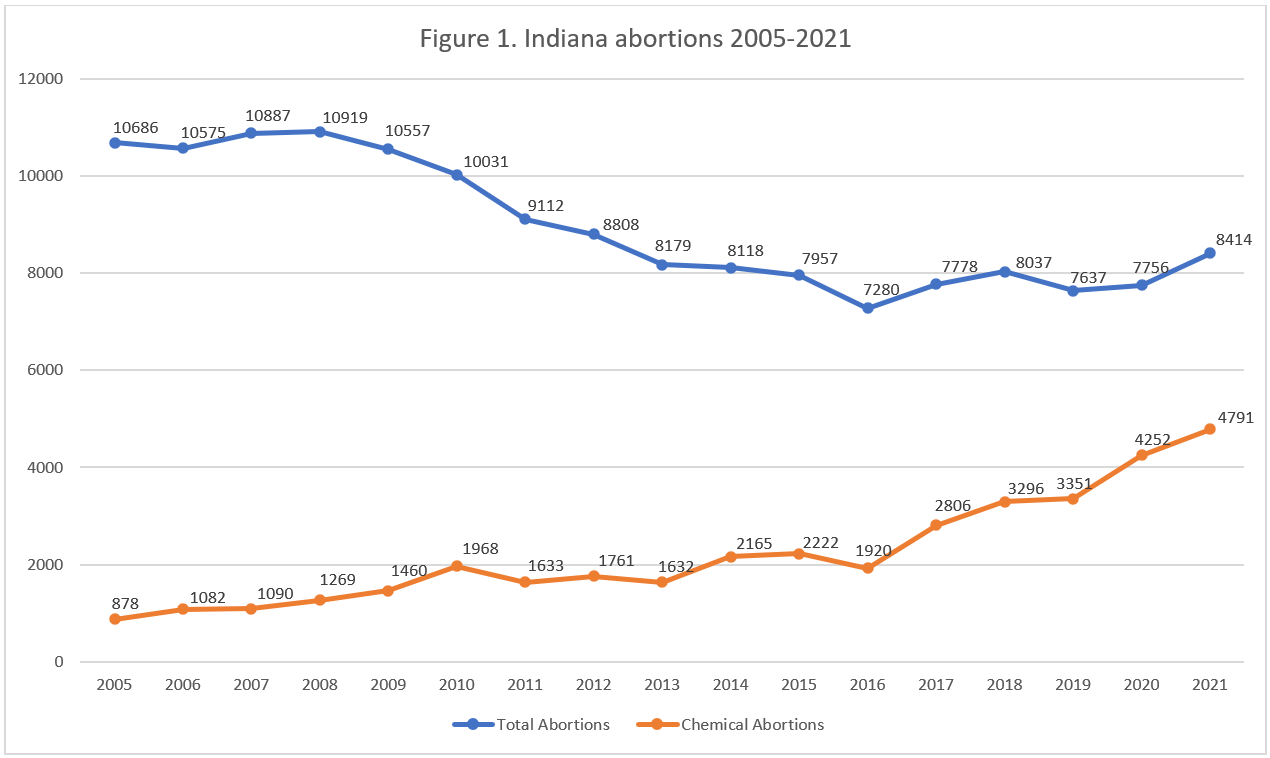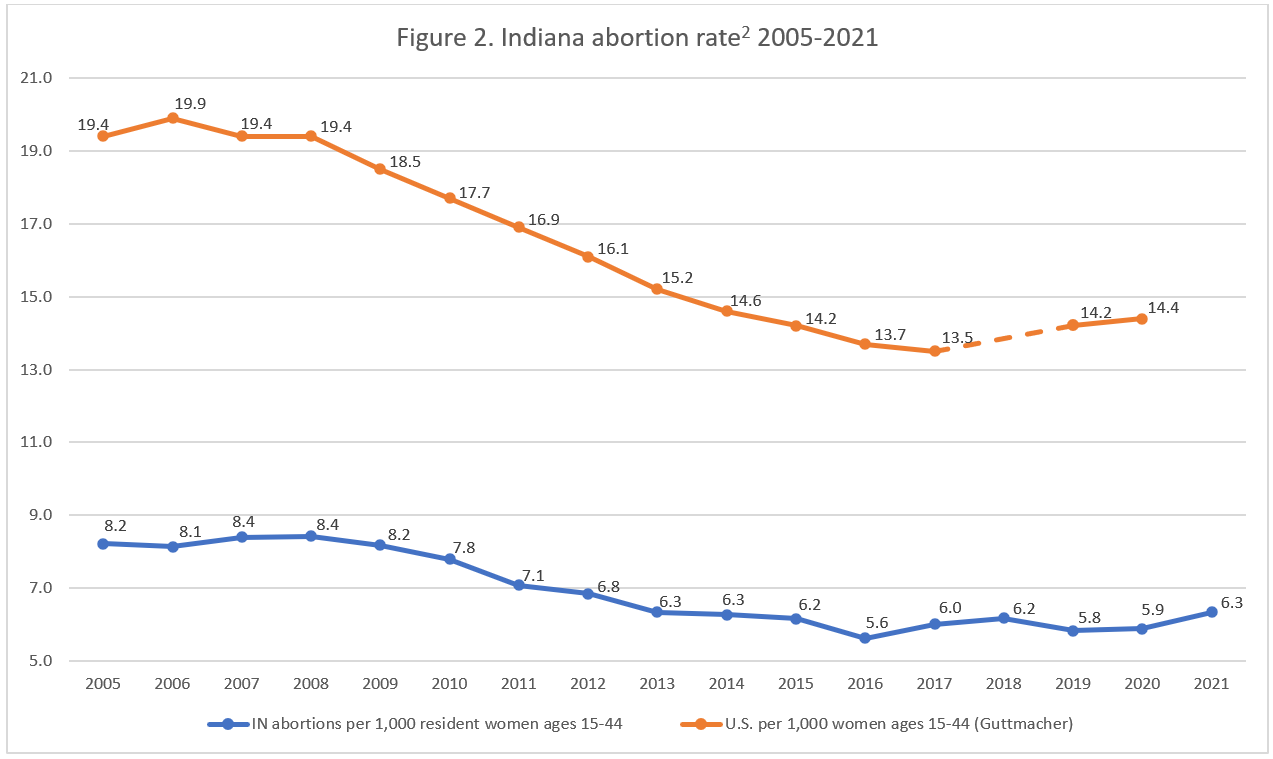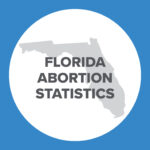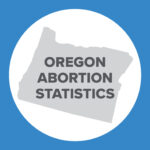Abortion Reporting: Indiana (2021)
Indiana’s 2021 abortion report was published in June 2022, revealing that Indiana abortions increased from 2020.
Statistics and Changes in Indiana Abortions, 2020-2021

Abortion Totals and Trends
In 2021, there were 8,414 abortions reported in Indiana, up eight percent from the previous year. Chemical abortions rose by 13 percent, making up over half of all abortions (57 percent) occurring in Indiana in 2021 (Fig. 1). The Charlotte Lozier Institute (CLI) estimates that Indiana’s 2021 abortion rate was 6.3 abortions per 1,000 women ages 15 to 44, an increase of 7 percent from 2020 (Fig. 2). As of November 2022, 24 states had released 2021 abortion statistics, of which 17 reported that abortions had increased from 2020.
State Report Summary
In 2021, 94 percent of the abortions reported in Indiana were performed on state residents. Six percent were obtained by nonresident women, including three percent on women from Kentucky. Over half of the abortions (59 percent) were on women in their twenties, with 31 percent performed on women ages 20 to 24 and 28 percent performed on women ages 25 to 29. Twenty-nine percent were performed on women in their thirties. Three percent of Indiana abortions were on women ages 40 and older, and nine percent were on girls under the age of 20.
Forty-eight percent of Indiana abortions were performed on white women. Thirty-five percent were on black women, and four percent were obtained by Asian women. Nine percent of Indiana abortions were performed on women of other races. Abortions obtained by American Indian women, women of multiple races, and women of unknown races each accounted for two percent of the total abortions reported in Indiana. The black abortion rate (19.2) was more than five times higher than the white abortion rate (3.7).
In 2021, eight percent of Indiana abortions were performed on women who had not completed high school. Thirty-seven percent were on women with a high school diploma or its equivalent, and 26 percent were obtained by women who had completed some college but did not have a degree. Twenty-nine percent of Indiana abortions were performed on women with a college degree. Level of education was unknown for four percent of the abortions.
Eighty-six percent of the abortions reported in Indiana were on unmarried women, while 14 percent were performed on married women. Thirty-seven percent of Indiana abortions were performed on women with no living children. A quarter were on women with one child, and 38 percent were on women with two or more children. Sixty-nine percent of the abortions were obtained by women with no previous abortions, compared to 20 percent on women with one prior abortion and 11 percent on women with more than one. Twenty percent of the abortions were performed on women who had previously had a miscarriage.
Over half of the abortions reported in Indiana, 57 percent, were chemical. Forty-three percent were surgical abortions. Twenty-four percent of Indiana abortions occurred at six weeks gestation or earlier. Forty-four percent were performed between seven and eight weeks, dropping to 31 percent between nine and 13 weeks. Relatively few abortions were reported after 13 weeks. There were 53 abortions between 14 and 19 weeks (.06 percent), 18 abortions were performed at 20 weeks, 33 at 21 to 30 weeks, and one at 31 weeks.
During the time period that this annual report covers, Indiana law limited abortion at 20 weeks’ post-fertilization, around 22 weeks of gestation. Abortions after 13 weeks had to be performed at acute care hospitals. Following the historic overturn of the Roe v. Wade (1973) Supreme Court decision in June 2022, the Indiana Legislature joined 14 other states in the post-Dobbs era by taking action to pass and sign into law strong legislation to protect the lives of moms and babies. Indiana’s new law prohibits abortion in all instances except in the case of fatal fetal anomalies, if the life or a major bodily function of the mother is at risk, and in the cases of rape and incest. The rape and incest exceptions apply to an abortion up to 10 weeks’ post-fertilization. This law went into effect on September 15, 2022, but was subsequently blocked by the Indiana Supreme Court in October 2022 via a temporary injunction The law remains blocked from enforcement while the state Supreme Court debates the constitutionality of the law.
Over half of Indiana abortions (51 percent) were performed in Planned Parenthood’s four Indiana abortion centers. Just over a quarter of Indiana abortions (28 percent) were performed in The Women’s Medical Center of Indianapolis, 16 percent occurred at Clinic for Women, and four percent were reported by Whole Woman’s Health of South Bend. One percent of the abortions occurred in hospitals. The month of January had the most abortions (793) and November had the fewest (604).
Abortion Complications
Indiana’s robust complication reporting law that was initially blocked by a court order and struck down in 2020 was eventually upheld by the U.S. Court of Appeals for the Seventh Circuit and went into effect in October 2021. In 2021, Indiana reported that the number of incomplete abortions (66 or 0.8 percent of total abortions) decreased from 2020 when the state reported 88 incomplete abortions (1.1 percent of total abortions). Sixty of the 66 incomplete abortions were completed surgically. In 2021, Indiana reported that 49 women experienced 51 other complications (women could report more than one complication). Thirty women reported retained products following their abortion and 21 reported other, unspecified complications.1
2021 Legislative Changes
In 2021, Indiana Governor Eric Holcomb (R) signed six pro-life measures into law. The two that apply to information covered in Indiana’s annual abortion report are included and described below.
- S3 – This bill contained a provision that prohibits the use of telehealth services to provide any abortion or abortion consultations, including the provision of chemical abortions pills via telehealth. The law took effect immediately, was temporarily blocked but nevertheless reinstated in September 2021.
- H1577 – This bill contained several amended pro-life provisions. One that applies to information covered in the state’s annual abortion reports includes the prohibition of chemical abortions after eight weeks of gestation, an earlier protection than he law’s previous nine-week limit. The bill also mandated that a physician dispense the pills in person, that the woman take the pills in the presence of the physician, and that the physician provide the woman with information about abortion pill reversal. Furthermore, the bill contained updated abortion reporting requirements that mandated the inclusion of the facility name and city where a pregnant woman provided informed consent. This bill never went into effect and is enjoined.
State Ranking
In 2016, CLI evaluated abortion reporting across the 50 states, New York City, and the District of Columbia, and Indiana’s reporting was ranked fifth best. Indiana could strengthen its abortion statistics by reporting the types of procedures used in the state in more detail and breaking down chemical and surgical abortions by gestational age.


- Statistics on abortion complications reported here represent a minimal number of deaths and complications, as this data is collected in a non-systematic and non-verifiable way. As such, this data cannot be used to calculate either an accurate abortion mortality rate or an accurate abortion complication rate for the state.
- Rates were calculated by CLI using the following formula: (total number of abortions performed in Indiana ÷ number of resident women ages 15-44) x 1,000. Rates may differ slightly from previous CLI articles due to revised population estimates. Population estimates were obtained from the CDC WONDER database. Estimates for 2005-2009 are intercensal estimates of the July 1 resident population. Estimates for 2010-2019 are Vintage 2020 postcensal estimates of the July 1 resident population. Estimates for 2020-2021 are Vintage 2021 postcensal estimates of the July 1 resident population. Estimates were produced by the U.S. Census Bureau and the National Center for Health Statistics.



























